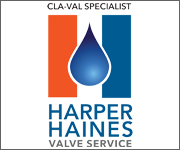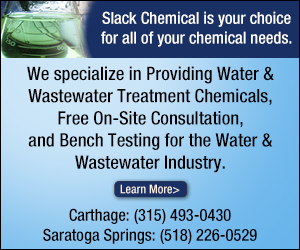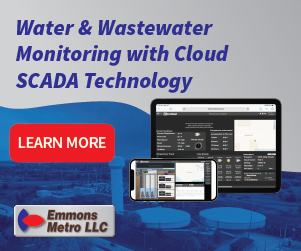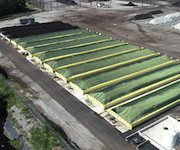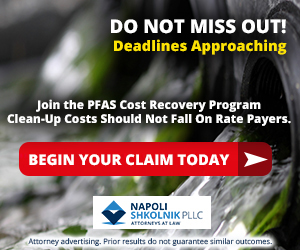 |
||||||||||||||||||||||||||||||||||||||
| Archive | Subscribe | nyruralwater.org | ||||||||||||||||||||||||||||||||||||||
|
NYRWA News
The NYS Department of Health, Bureau of Water Supply Protection, has released an approved spreadsheet template for use in documenting your water systems Lead Service Line Inventory (LSLI). All Community Water Systems and Non-Transient, Non-Community Water Systems are required to collect data, generally from records such as curb cards or as built maps, or from excavations, that will determine the type of service line material on both the water systems side and the customers side entering the home. NYRWA will be providing at least 10 training sessions over the next 12 months in conjunction with the NYS Dept. of Health, Bureau of Water Supply Protection, that will have one segment dealing with this issue. If you need further assistance, please see the link to the template below, and please feel free to reach out to our Circuit Riders and Training Specialist for assistance. The initial Lead Service Line Inventory will need to be submitted by October 16, 2024. There is much more to this rule, this is merely a brief summary and a link to the spreadsheet. You can download the Inventory Template on the nyruralwater.org website under “Resources”, where you will click the “Download” link and choose “Templates” and find NYS DOH Approved Lead Service Line Inventory Spreadsheet. (Once you click this link a pop up box should appear somewhere on your screen to download the spreadsheet) Please save the dates for our 44th Annual Workshop in Lake Placid, May 22 - 24, 2023! If you are interested in being a presenter, please complete the Call For Presentation request form and return by August 15, 2022 to be considered for next year's conference. Sponsorship Opportunities are available, review the letter, if interested please complete the sponsorship form with your selection and email to our office nyrwa@nyruralwater.org
Have you received water and/or wastewater technical assistance from NYRWA? Have you attended NYRWA in-person or web-based training? Has your system benefited from a Source Water Protection Plan or Energy Efficiency Assessment from NYRWA? If so, WE NEED YOUR HELP! NYRWA is respectfully asking our system members to draft and submit letters of support for the services you have received. These letters are crucial so we can deliver your message to our elected representatives that more needs to be done to fund water and wastewater infrastructure. Please, we need as many members as possible to draft the support letters on your letterhead and mail to our office at: NYRWA, Inc. Let’s make this letter writing campaign a huge success, please participate. We thank you in advance for your consideration.
Upcoming Training
Don't have time to spend traveling to sit in a class all day? The best place to receive renewal web based training is at home or work, whichever your schedule allows. You can work at your own pace. SunCoast Learning Systems offers some great topics that will fit your certification requirement needs. Online courses are New York State approved and offer the flexibility and convenience you are looking for. For more information call 1-800-269-1181 or visit https://www.suncoastlearning.com/courses/ny. Events
Industry News
The agency is releasing PFAS health advisories in light of newly available science and in accordance with EPA’s responsibility to protect public health. These advisories indicate the level of drinking water contamination below which adverse health effects are not expected to occur. Health advisories provide technical information that federal, state, and local officials can use to inform the development of monitoring plans, investments in treatment solutions, and future policies to protect the public from PFAS exposure. EPA’s lifetime health advisories identify levels to protect all people, including sensitive populations and life stages, from adverse health effects resulting from a lifetime of exposure to these PFAS in drinking water. EPA’s lifetime health advisories also take into account other potential sources of exposure to these PFAS beyond drinking water (for example, food, air, consumer products, etc.), which provides an additional layer of protection. EPA is issuing interim, updated drinking water health advisories for perfluorooctanoic acid (PFOA) and perfluorooctane sulfonic acid (PFOS) that replace those EPA issued in 2016. The updated advisory levels, which are based on new science and consider lifetime exposure, indicate that some negative health effects may occur with concentrations of PFOA or PFOS in water that are near zero and below EPA’s ability to detect at this time. The lower the level of PFOA and PFOS, the lower the risk to public health. EPA recommends states, Tribes, territories, and drinking water utilities that detect PFOA and PFOS take steps to reduce exposure. Most uses of PFOA and PFOS were voluntarily phased out by U.S. manufacturers, although there are a limited number of ongoing uses, and these chemicals remain in the environment due to their lack of degradation. For the first time, EPA is issuing final health advisories for perfluorobutane sulfonic acid and its potassium salt (PFBS) and for hexafluoropropylene oxide (HFPO) dimer acid and its ammonium salt (“GenX” chemicals). In chemical and product manufacturing, GenX chemicals are considered a replacement for PFOA, and PFBS is considered a replacement for PFOS. The GenX chemicals and PFBS health advisory levels are well above the level of detection, based on risk analyses in recent scientific studies. The agency’s new health advisories provide technical information that federal, state, and local agencies can use to inform actions to address PFAS in drinking water, including water quality monitoring, optimization of existing technologies that reduce PFAS, and strategies to reduce exposure to these substances. EPA encourages states, Tribes, territories, drinking water utilities, and community leaders that find PFAS in their drinking water to take steps to inform residents, undertake additional monitoring to assess the level, scope, and source of contamination, and examine steps to reduce exposure. Individuals concerned about levels of PFAS found in their drinking water should consider actions that may reduce exposure, including installing a home or point of use filter. Next Steps EPA is moving forward with proposing a PFAS National Drinking Water Regulation in fall 2022. As EPA develops this proposed rule, the agency is also evaluating additional PFAS beyond PFOA and PFOS and considering actions to address groups of PFAS. The interim health advisories will provide guidance to states, Tribes, and water systems for the period prior to the regulation going into effect. The EPA’s work to identify and confront the risks that PFAS pose to human health and the environment is a key component in the Biden-Harris Administration whole-of-government approach to confronting these emerging contaminants. This strategy includes steps by the Food and Drug Administration to increase testing for PFAS in food and packaging, by the U.S. Department of Agriculture to help dairy farmers address contamination of livestock, and by the Department of Defense to clean-up contaminated military installations and the elimination of unnecessary PFAS uses. To receive grant funding announced today through the Bipartisan Infrastructure Law, states and territories should submit a letter of intent by August 15, 2022. As part of a government-wide effort to confront PFAS pollution, EPA is making available $1 billion in grant funding through President Biden’s Bipartisan Infrastructure Law to help communities that are on the frontlines of PFAS contamination, the first of $5 billion through the Law that can be used to reduce PFAS in drinking water in communities facing disproportionate impacts. These funds can be used in small or disadvantaged communities to address emerging contaminants like PFAS in drinking water through actions such as technical assistance, water quality testing, contractor training, and installation of centralized treatment technologies and systems. EPA will be reaching out to states and territories with information on how to submit their letter of intent to participate in this new grant program. EPA will also consult with Tribes and Alaskan Native Villages regarding the Tribal set-aside for this grant program. This funding complements $3.4 billion in funding that is going through the Drinking Water State Revolving Funds (SRFs) and $3.2 billion through the Clean Water SRFs that can also be used to address PFAS in water this year. New Members
|
||||||||||||||||||||||||||||||||||||||
